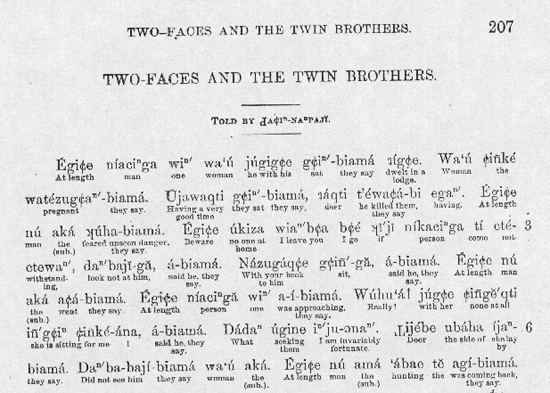INTRODUCTION
Aho! Dear Reader: The following Umónhon hígon (Omaha story) has been re-transcribed and updated by the Omaha language class at the University of Nebraska-Lincoln (UNL). We are housed in the Department of Anthropology-Geography and jointly supported by the Native American Studies Program and the Institute for Ethnic Studies. This story was worked on by the second cycle of students (2002–2004) to complete the four semester series of Omaha language.
The creation of this booklet is part of a larger, on-going Omaha Language Curriculum Development Project. This project seeks to address the need for quality, versatile teaching materials in the Omaha language. It is a concern for the UNL program as well as for many of the educators at Umónhon Nation Public School (UNPS) and in the community at large.
I first heard Two Faces and the Twin Brothers as it was narrated in the early 1970s by Elizabeth Saunsoci Stabler, an Omaha elder teaching Omaha language at the Lincoln Indian Center. Grandma Elizabeth recalled being told the story many times by her grandfather. She described the scene where all of the children would be tucked into bed in a darkened room. There were dancing lights and shadows in the room due to the cracks in the wood burning stove. Her grandfather's deep Omaha voice was disembodied, seeming to emerge from the darkness. When Grandma Elizabeth recounted the story she ended at the point where the Elder Twin Brother sang his lament about eating wild beans. When I asked her what came next she replied that she had always fallen asleep at that spot in the story and never heard the rest.
I encountered a fuller version of the story collected by James Owen Dorsey from Páthiⁿnonpazhi (Not Afraid of Pawnees), later known as Jordan Stabler, in the late 19th century. Dorsey transcribed the Omaha version with interlinear English translations in his 1890 volume of Omaha-Ponca language "The egiha Language," published by the Government Printing Office, Washington, D.C., for the U.S. Geographical and Geological Survey of the Rocky Mountain Region (Figure 1).
 Figure 1. Opening lines of Two Faces and the Twin Brothers as narrated by Páthinnonpazhi. Transcribed and interpreted by
James Owen Dorsey in, The egiha Language (1890:207)
Figure 1. Opening lines of Two Faces and the Twin Brothers as narrated by Páthinnonpazhi. Transcribed and interpreted by
James Owen Dorsey in, The egiha Language (1890:207) The UNL Omaha language class was challenged to re-transcribe the Dorsey orthography into the current UNL/UNPS writing system. Working with the UNL Native speakers, Emmaline Walker Sanchez and Alberta Grant Canby, the students began to update the words and phrases. It was decided to reorganize the story into a more active voice in a reader's theater style. This resulted in the deletion of many of the á-biamá "he said, they allegedly say", an oral narrative feature (Figure 2). We intentionally kept the repetitive format where actions occur in sequences of four as a language reinforcement device and to respect the Omaha tradition. A few sentences were added to explain how the Elder Twin was raised by mice, to give a personality to each of the four Thunderbirds, and to conclude with a summary of Omaha values depicted in the story. The words in the first song about wild beans have been modified slightly to replicate how Grandma Elizabeth Stabler rendered it in the mid 1970s. Musical notation for the first song, lacking in the Dorsey version, was scored by John Mangan at Umonhon Nation Public School.
 Figure 2. Opening lines of Two Faces and the Twin Brothers as first re-transcribed and updated by the UNL Omaha Language class,
2002-2004
Figure 2. Opening lines of Two Faces and the Twin Brothers as first re-transcribed and updated by the UNL Omaha Language class,
2002-2004 In the spring of 2004, the Omaha IV students carried the revised draft to the UNPS Umonhon Language Center on the Omaha Reservation and consulted with their team of Native speakers. Elders Susan Freemont and Alice Saunsoci, Director Vida Stabler, and Linguist Ardis Eschenberg reviewed the story with the students. Because they were familiar with the storyline from their childhood days, Grandma Susan and Aunt Alice became quite animated as we all worked through the adventures of the Twins, anticipating what would come next in the narrative. The ULC team reaffirmed the UNL student version and offered minor vocabulary and phrasing changes.
In 2004, the UNL Omaha language class commissioned UNPS students, under the direction of UNPS art teacher Heather Rogers, to produce 35 illustrations for the story. Thomas Webster, Yancy Morris, Brian Cordona, John McCauley, Scott Cayou, and Chanika Morris contributed their artistic talents and interpretations to this task. We appreciate their efforts.
The next step will be to challenge the current UNL Omaha language students (2004–2006) to produce an audio version of the Two Faces story. It is my belief that this story belongs in the oral, rather than written, format. The expectation is that the audio tape or CD will provide a context-rich language and culture experience for the listener.
Everyone has worked diligently to double-check translations and spelling. Any errors or oversights are the responsibility of the Instructor. Please forgive me. Wíbthahon.
Print copies of this booklet with the audio CD are available for purchase from:
Omaha Language Class
Department of Anthropology-Geography
University of Nebraska
Oldfather Hall 810
Lincoln, NE 68588-0368
